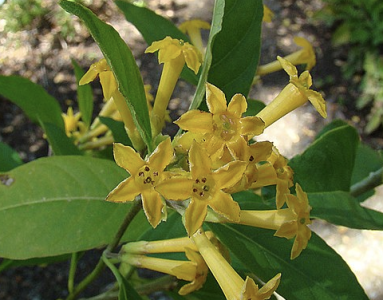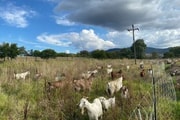You’ve probably seen this plant before… and it might be deadly. Here’s why you should be worried
- Replies 0
If you’re a keen gardener or simply enjoy a stroll through the Aussie bush, you might want to take a closer look at what’s growing in your backyard or local paddock.
Authorities are sounding the alarm over a 'nasty' and highly toxic plant that’s been causing 'horrific' deaths among livestock—and it could be lurking closer to home than you think.
The culprit in question is the green cestrum (Cestrum parqui), a seemingly innocuous shrub with glossy green leaves and clusters of yellowish flowers.
But don’t be fooled by its appearance—this plant is a wolf in sheep’s clothing. All parts of the green cestrum, especially its berries, are extremely poisonous to people, pets, and livestock.
The warning comes after a devastating incident in the NSW Central West, where seven cows died within just a few days after ingesting the plant.
Dr Kate Atkinson, a district veterinarian with Central West Local Land Services, explained that green cestrum poisoning is swift and brutal. 'It causes acute liver failure in animals, which often results in sudden death. In most cases, producers will just find animals dead in the paddock,' she said.

While cattle are the most commonly affected, green cestrum doesn’t discriminate—sheep, horses, goats, and even household pets can fall victim if they ingest enough of the plant.
Sometimes, if an animal eats a smaller amount, you might notice symptoms before the worst happens: abdominal pain (such as kicking at their belly), unsteadiness, wobbling, or even seizures. But if the dose is high, death can occur within hours.
The timeline from ingestion to death can vary, depending on how much was eaten and the plant’s toxicity at the time. 'It can happen within a few hours, or take up to two days after ingestion,' Dr Atkinson said.
In the recent NSW case, up to ten cattle from a single mob died in just a few days.
You might think animals would avoid something so dangerous, but that’s not always the case. While green cestrum is often described as unpalatable, Dr Atkinson warns that livestock will eat it—sometimes even when there’s plenty of other feed available.
The risk increases in winter when green feed is scarce, but poisonings have been reported year-round.
Here’s the scary part: there’s no effective treatment for green cestrum poisoning. Once an animal has eaten a fatal dose, there’s little anyone can do.
'If it’s a lower dose, they might recover, but the only way to reduce risk is to keep stock away from affected areas,' Dr Atkinson said.
Source: Local Land Services NSW / Youtube.
If you spot green cestrum on your property, don’t rush in with the secateurs. Removal must be done with care.
Spraying with herbicide can actually make the plant more dangerous in the short term, as wilting leaves become more palatable to animals. Stock should be kept well away until the plant is completely gone.
Patricia Lu-Irving from the Royal Botanic Gardens in Sydney recommends wearing gloves and protective clothing when handling green cestrum.
A combination of mechanical removal (digging out all roots) and herbicide treatment is most effective, with follow-up checks for regrowth and hand removal of seedlings in autumn.
Green cestrum isn’t just a danger to animals. Dr Carol Booth from the Invasive Species Council warns that it also outcompetes native plants, threatening several already endangered ecological communities.
Originally introduced from South America as a garden plant, green cestrum has now spread across multiple Australian states, thanks to birds eating its berries and floods dispersing its seeds.
What does green cestrum look like?
Read more: Favourite garden plant hides danger to pets—discover which one is deadly

Have you spotted this plant in your area, or had a close call with a toxic weed? Share your stories, tips, or questions in the comments below!
Authorities are sounding the alarm over a 'nasty' and highly toxic plant that’s been causing 'horrific' deaths among livestock—and it could be lurking closer to home than you think.
The culprit in question is the green cestrum (Cestrum parqui), a seemingly innocuous shrub with glossy green leaves and clusters of yellowish flowers.
But don’t be fooled by its appearance—this plant is a wolf in sheep’s clothing. All parts of the green cestrum, especially its berries, are extremely poisonous to people, pets, and livestock.
The warning comes after a devastating incident in the NSW Central West, where seven cows died within just a few days after ingesting the plant.
Dr Kate Atkinson, a district veterinarian with Central West Local Land Services, explained that green cestrum poisoning is swift and brutal. 'It causes acute liver failure in animals, which often results in sudden death. In most cases, producers will just find animals dead in the paddock,' she said.

Aussies are being urged to stay vigilant for green cestrum, a highly toxic, invasive plant that has recently caused multiple sudden deaths in cattle, and is a danger to pets, livestock and people. Image source: Dick Culbert / Wikimedia Commons.
While cattle are the most commonly affected, green cestrum doesn’t discriminate—sheep, horses, goats, and even household pets can fall victim if they ingest enough of the plant.
Sometimes, if an animal eats a smaller amount, you might notice symptoms before the worst happens: abdominal pain (such as kicking at their belly), unsteadiness, wobbling, or even seizures. But if the dose is high, death can occur within hours.
The timeline from ingestion to death can vary, depending on how much was eaten and the plant’s toxicity at the time. 'It can happen within a few hours, or take up to two days after ingestion,' Dr Atkinson said.
In the recent NSW case, up to ten cattle from a single mob died in just a few days.
You might think animals would avoid something so dangerous, but that’s not always the case. While green cestrum is often described as unpalatable, Dr Atkinson warns that livestock will eat it—sometimes even when there’s plenty of other feed available.
The risk increases in winter when green feed is scarce, but poisonings have been reported year-round.
Here’s the scary part: there’s no effective treatment for green cestrum poisoning. Once an animal has eaten a fatal dose, there’s little anyone can do.
'If it’s a lower dose, they might recover, but the only way to reduce risk is to keep stock away from affected areas,' Dr Atkinson said.
Source: Local Land Services NSW / Youtube.
If you spot green cestrum on your property, don’t rush in with the secateurs. Removal must be done with care.
Spraying with herbicide can actually make the plant more dangerous in the short term, as wilting leaves become more palatable to animals. Stock should be kept well away until the plant is completely gone.
Patricia Lu-Irving from the Royal Botanic Gardens in Sydney recommends wearing gloves and protective clothing when handling green cestrum.
A combination of mechanical removal (digging out all roots) and herbicide treatment is most effective, with follow-up checks for regrowth and hand removal of seedlings in autumn.
Green cestrum isn’t just a danger to animals. Dr Carol Booth from the Invasive Species Council warns that it also outcompetes native plants, threatening several already endangered ecological communities.
Originally introduced from South America as a garden plant, green cestrum has now spread across multiple Australian states, thanks to birds eating its berries and floods dispersing its seeds.
What does green cestrum look like?
- Leaves: Glossy, dark green, and lance-shaped.
- Flowers: Clusters of tubular, yellowish-green flowers, often with a strong scent.
- Berries: Shiny black when ripe—these are especially toxic.
Read more: Favourite garden plant hides danger to pets—discover which one is deadly
Key Takeaways
- Aussies are being urged to stay vigilant for green cestrum, a highly toxic, invasive plant that has recently caused multiple sudden deaths in cattle, and is a danger to pets, livestock and people.
- There is no effective treatment for green cestrum poisoning, which causes acute liver failure and often leads to rapid death; prevention and keeping stock away from infested areas is critical.
- Removal of green cestrum must be undertaken carefully, as spraying with herbicide can temporarily make the plant more palatable and increase the risk to animals; stock should be kept away until the plant is completely eradicated.
- Experts warn that green cestrum spreads easily, especially by birds and during floods, and all parts of the plant – particularly the berries – are very poisonous; landholders should report sightings and handle the plant with gloves and protective clothing.
Have you spotted this plant in your area, or had a close call with a toxic weed? Share your stories, tips, or questions in the comments below!







